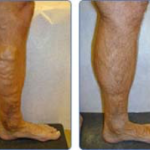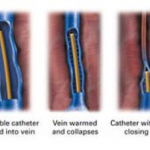Varicose Veins
How can varicose veins be treated?
Regular exercise, standing only when necessary, and elevating your legs while sitting and sleeping might keep your varicose veins from getting worse. Wearing special elastic support stockings during daily activities also can provide extra support and relieve aching, sore legs. When you need to stand for long periods of time, take frequent breaks to sit down and elevate your feet.
Depending on the size and location, varicose veins can be treated with surgery, injections (sclerotherapy), or endoluminal ablation, this can be done with laser technology or radiofrequency technology.
What is sclerotherapy?
Sclerotherapy is a non-surgical treatment option that involves injecting a chemical solution into the veins to make them collapse. Because the veins can no longer carry blood, they will eventually disappear. The work of carrying the blood is shifted to other healthy veins nearby, improving venous circulation.
Sclerotherapy requires multiple sessions, since one to three injections are usually required to effectively seal the veins. Ten to 40 veins may be treated in one session. The same area should not be injected for four to six weeks to allow for complete healing, although other areas may be treated during this time.
The only discomfort during sclerotherapy is the sensation of small needle pricks. For two to four weeks after treatment, you will wear medical-grade support stockings. Walking and moderate exercise also can help speed recovery. Temporary reactions to the treatment might include slight swelling of the leg or foot, minor bruising, itching, redness, or mild soreness. Rare complications include telangiectatic matting (new, tiny blood vessels), skin ulcerations, and brown pigmentation around the treated vessels.
Once treated, the veins disappear over a period of six months and do not recur. However, sclerotherapy treatment cannot stop new varicose or spider veins from developing.
A thin catheter is used to deliver radiofrequency energy to the wall of the great saphenous vein
What is Radiofrequency therapy?
Radiofrequency (RF) therapy is a minimally invasive alternative to traditional vein stripping. It’s done by inserting a very small tube called a catheter into the vein and delivering radiofrequency energy to the vein wall. This causes the vein to shrink, collapse and seal shut. Once it’s sealed, healthy veins take over. The radiofrequency procedure can be performed under local anesthesia. Patients have reported little, if any, pain during the procedure, and most return to normal activity within a day. Some common side effects include temporary tenderness and numbness. You can expect a noticeable improvement within 1 to 2 weeks, with good cosmetic outcomes and little to no scarring. The procedure is often supplemented by sclerotherapy to clear up any residual veins. For more information go to www.VNUS.com
Venous closure using glue
A recent development is the introduction of glue to permanently close varicose veins so that they collapse and become like a thread of scar tissue under the skin and cannot be seen. The technique is similar to radiofrequency in that a catheter is placed in the vein (usually below the knee) and passed to the top of the vein near the groin. The catheter is withdrawn and tiny amount of glue is injected. The vein is held closed for 30sec while the glue sets. No anaesthetic is needed other than a small injection at the point where the catheter is introduced. The procedure can be done as a walk in walk out treatment.

